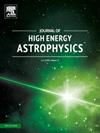Gamma ray flares from active region within inhomogeneous AGN jet
IF 10.2
4区 物理与天体物理
Q1 ASTRONOMY & ASTROPHYSICS
引用次数: 0
Abstract
Two stages of non-thermal emission from relativistic jets in active galaxies can be distinguished: a low level persistent emission and a high level variable emission. It has been recently proposed that both stages are produced in the inner (parsec scale) jet region where electrons are accelerated to TeV energies. We consider a scenario in which the low-level persistent emission originates in the extended, parsec-scale jet but the high level emission is produced by electrons accelerated in a localized region within the inner jet. Our aim is to calculate self-consistently the non-thermal emission expected from the AGN jet in different radiation stages. Then, we will be able to model different emission stages observed in blazars in terms of a single scenario. We modify the stationary, non-local, inhomogeneous AGN jet model for the stationary jet emission by introducing a small active region within the stationary jet, whose physical parameters differ significantly from those in the extended large-scale jet. We distinguish four different emission components which are due to the interaction of relativistic electrons in the active region with the radiation from the active region and radiation from the extended jet and also due to the electrons in the extended jet, which comptonize synchrotron radiation from the extended jet and the active region. Depending on the nature of the active region, we are able to explain the appearance of different types of emission levels in BL Lac type blazars, i.e. the high states observed only in the X-rays or only in the γ-rays. Moreover, we predict the existence of a new type of high emission state in BL Lacs, so called the orphan MeV-soft synchrotron state, in which the inverse Compton emission is mainly limited to the MeV energy range. Such type of blazars have not been observed up to now due to the limited sensitivity of telescopes in the MeV energy range.
求助全文
约1分钟内获得全文
求助全文
来源期刊

Journal of High Energy Astrophysics
Earth and Planetary Sciences-Space and Planetary Science
CiteScore
9.70
自引率
5.30%
发文量
38
审稿时长
65 days
期刊介绍:
The journal welcomes manuscripts on theoretical models, simulations, and observations of highly energetic astrophysical objects both in our Galaxy and beyond. Among those, black holes at all scales, neutron stars, pulsars and their nebula, binaries, novae and supernovae, their remnants, active galaxies, and clusters are just a few examples. The journal will consider research across the whole electromagnetic spectrum, as well as research using various messengers, such as gravitational waves or neutrinos. Effects of high-energy phenomena on cosmology and star-formation, results from dedicated surveys expanding the knowledge of extreme environments, and astrophysical implications of dark matter are also welcomed topics.
 求助内容:
求助内容: 应助结果提醒方式:
应助结果提醒方式:


